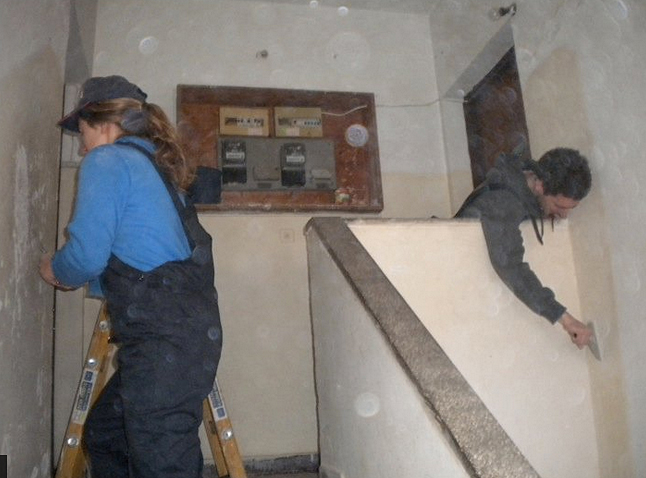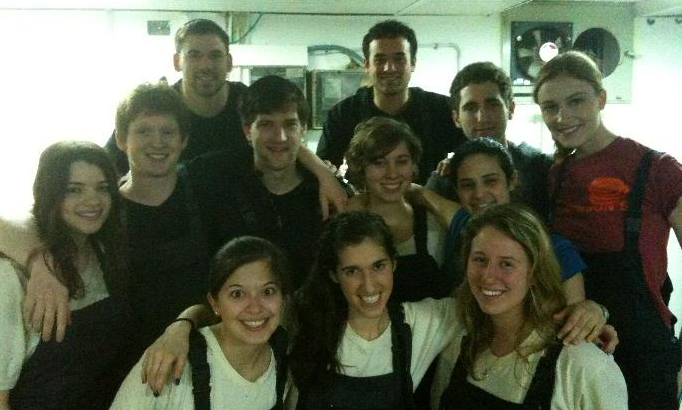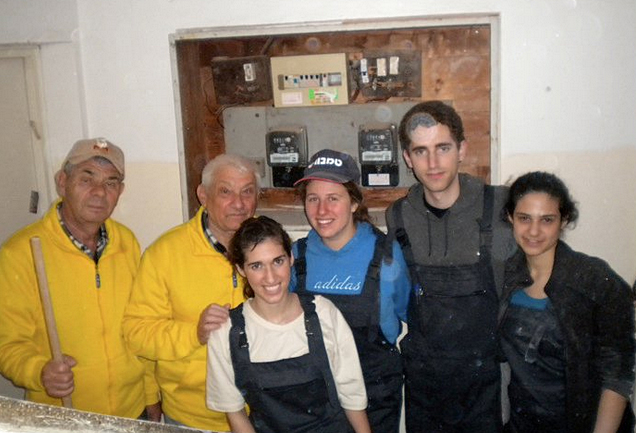OldSpeak
Building Bomb Shelters
By Carrie Filipetti
March 28, 2011
 |
Last week, it was the site of a bus explosion that injured 39 and killed one.
The week before that, it was the site of a brutal slaughter of five people, one a three-month-old child, while they were innocently sleeping in their beds.
It’s the place where second-grade playgrounds are made out of concrete to serve as make-shift bomb shelters; where children have 15 seconds to less to duck and cover from a terrorist attack; where surprise attacks from surrounding nations come on the holiest day of the year; and where 18-year-old girls and boys are forced into military service not by an oppressive regime but because the very existence of their nation depends on it.
It’s the one place in the world that is attacked—unprovoked—by over 10,000 rockets not during a time of war – but during a time of peace; and the only country in the world that is then condemned for generating a response to said attacks. It is the country whose very existence, despite being formed by an international vote by a respected multinational body after protracted and serious debate, is contested by its neighbors. And yet, despite all of these things – despite the attacks against it, despite the hatred that surrounds it, it is the one place in the world where I feel safe, and home.
It is Israel, and I am a Jew. And while many misunderstand the deep connections that drawJewish Americans to Israel, casting it as dual loyalty or excessive messianism, it is borne of neither of those things. It is borne of necessity.
Earlier this weekend, one of my closest friends was attacked for being Jewish at one of the top public Universities in the United States. It is not a new story, but it is an unreported one. Each year, the FBI hate crime statistics tell us the same thing – that of every religious group in the United States, Jews remain the most targeted both in numbers and proportions. In 2009, of the 1,575 victims of anti-religious hate crimes, 71.9% were committed because of the offender’s anti-Jewish bias, as compared with 8.4% because of anti-Muslim bias, the second most targeted group. In fact, overall, while anti-Muslim attacks have largely trended downward since 2001, anti-Jewish attacks have increased (though prior to 2001, they were equally as high, if not higher, than they are today). Anti-Semitism, not just anti-Zionism, thrives; and yet, we – Jews, our families, our friends, the media, whoever – turn the other cheek. Some argue that it is Israel that is causes these biases, but to those I would ask – how many Jews were targeted before the establishment of Israel? Let’s start with the immediate context of the establishment of Israel: 1939-1945. Earlier? Let’s go back to the eras of pogroms in Eastern Europe, to the creation of the Pale of Settlement; back to the Spanish Inquisition, back to the exile of Jews from European nations, including Spain, Portugal, and England; back to the Black Death, where Jews were blamed for poisoning the wells; back to the Crusades, where Jews were targeted for rape and murder by both sides; back to Bohdan Khmelnytsky’s Cossacks; back to Muslim pogroms in the Iberian Peninsula, back to Persian attempts at early genocide and the original exile of the Jews from Israel in the ancient period.
It seems that Israel is not so much a cause of but an excuse for continued anti-Semitism. And such is the origin of the complexity with which I approach Israel. Though Israel may provide nothing more than an excuse for those who would otherwise hate Jews anyway, is there a need to provide the excuse in the first place? Does Israel do more harm than good by convincing those already inclined toward anti-Semitism of particular stereotypes? Does it homogenize the Jewish people – force them to behave a certain way, to support certain behaviors, accept certain distinctions?
 |
|
A portion of the student volunteers from the University of Virginia.
|
This Spring, I went to Nahariyya, Israel, where I was charged with refurbishing bomb shelters – which double as community centers – along with 18 of my peers at the University of Virginia. The trip was organized by the American Jewish Joint Distribution Committee, which has a long and proud history of assisting Jewish communities around the world. I participated in the trip as a means of trying to answer the above questions – despite the hope Israel provides to Jews around the world, despite its goal of providing a refuge for Jews who have been targeted simply because of their religious beliefs or cultural heritage, does Israel do more harm than good?
Nahariyya is a mere six miles from the border with Lebanon. When Hizbollah launched the Second Lebanon War in 2006, many of the residents of this largely elderly, immigrant town were forced to spend their time in the bomb shelters, which sustained serious damage during the course of the two month conflict. And it is not the only town. Sderot, which is far South, has been hit by rocket fire on a daily basis since the 2005 Israeli withdrawal from Gaza; in 2008, Israel was forced to mount Operation Cast Lead in response to increased rocket fire against cities increasingly close to Tel Aviv, including Ashdod and Ashkelon. While there were numerous places we could have gone to provide needed help, Nahariyya was selected because of the level of damage of the shelters and the inability of its residents – most of whom are older immigrants from the Former Soviet Union – to complete the repairs themselves.
Our trip lasted just under a week – not even enough time to grab a falafel, let alone ponder the deeper value and meaning within the existence of the Jewish state. Or was it? Sometimes, it is in the smallest moments that the most profound discoveries are made – the falling of an apple, the posting of grievances on a church door, the sound of the footsteps of 250,000 men and women marching toward the Mall.
While in Israel, we painted doors, we decorated murals, we planted gardens, and we turpentined the floors. We worked side-by-side with elderly Arabs and Russians, none of whom could speak English and only some of whom spoke Hebrew. As someone who had hoped to connect with Israelis – to find out about their experiences, to get answers to pressing questions – I found myself increasingly frustrated with my inability to communicate with my coreligionists. Nothing seemed familiar – nothing seemed “home,” or necessary, about this place. The Arab contractor told me I couldn’t paint because I was a woman; the Russian men stole my paintbrushes because I was doing it wrong, and any attempts to tell me so came off as aggressive and indistinguishable mumblings in a language I couldn’t understand. The signs – all in modern Hebrew script – gave me absolutely no indication of where I was or what was inside. Slowly, I found my sense of connection with Israel deteriorating. Always yearning for Israel while in America, while in Israel, I found my heart increasingly yearning for America.
And then, it was Shabbat, the Jewish day of rest. I chose to spend the evening with a modern Orthodox Jewish family, which required me to walk 20 minutes to synagogue and then an additional thirty minutes to his home. As we walked together, the breeze from the ocean turning from calm and welcome to a deep chill, we spoke on our lives. I was from NY. He was from Israel. I was reform. He was orthodox. There was little we had in common. But there was one thing. We were both Jewish, and we were walking together, despite having never met before, to his home, where I would be introduced to his family and given a four-course, home-cooked meal.
On the way, we passed other men and women on the street, dressed in their best, walking to and from synagogue. And everyone we passed smiled at us, waved, and quietly spoke the traditional words of greeting on Shabbat – “Shabbat Shalom.”
Never have two words, so easily passed through the lips, been so meaningful. Though I could not understand our Russian co-workers, I could understand them when they spoke this phrase, and they could understand me. And not only understand the literal meaning – “Have a Peaceful Sabbath” – but I understood the entirety of its history. I understood that this night, as on every Sabbath for millennia, Jews would gather in synagogue, and then in their homes, celebrating God’s creation and enjoying an abundance of food and good company. I understood that here, I would always have something that connects me with everyone around me – a shared history, a shared religion, a shared sense of identity.
So what have I learned? In the end, that Israel – regardless of the violence perpetrated against it, regardless of its manipulation and vilification by its enemies, regardless of its portrayal in the media – is the only place where Jews can be Jews. Though Jews are attacked, Judaism lives on. And I learned – it is not that I was building a bomb shelter for Israel; Israel is building a bomb shelter for me. Sure, it may not be pretty. It may seem overly reclusive, or paranoid. And it may not be particularly good at communicating with the media. But it saves lives, and equally importantly, it saves Judaism. The overall importance of Israel is that it converted converted something implicit in Judaism into something explicit, because finally we Jews eschewed the stereotypes cast upon us by our enemies and created a Judaism of strong, dedicated, and articulate people. Because Israel helps those of us who have forgotten remember who we are, and what we stand for. She teaches us to raise our heads in pride, not lower them in apologies. She teaches us that we are can be soldiers of the pen and the sword – she teaches us that we can be what we have been told for over 2000 years we cannot; and she teaches us that, no matter what, on a Friday night, we can wear our kippot and say “Shabbat Shalom” — and we will never be attacked for it.
 |
|
While in Nahariyya, students worked with Russian immigrants, with whom they struggled to communicate.
|
DISCLAIMER: THE VIEWS AND OPINIONS EXPRESSED IN OLDSPEAK ARE NOT NECESSARILY THOSE OF THE RUTHERFORD INSTITUTE.


